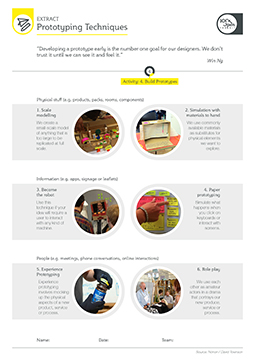Prototyping Techniques
“Developing a prototype early is the number one goal for our designers.We don't trust it until we can see it and feel it.”
Win Ng


This tool sets out six techniques we can use to prototype a new product, service or process.

These techniques prototype our three types of touchpoint: Physical stuff, Information andPeople. We pick one or more that are suitable. See Blueprint for more information on touchpoints.
1. Scale modelling
We create a small-scale model of anything that is too large to be able to replicate at full scale. This is useful for spaces or entire buildings when we want to think through the effectiveness of a new layout.
2. Simulation with materials to hand
We use commonly available materials as substitutes for physical elements we want to explore. We work quickly, not worrying too much about how things look on the surface.
3. Become the robot
Use this technique if your idea will require a user to interact with any kind of machine (e.g. ticket machine, vending machine, computer, phone). One person is the machine, a colleague the user and we act out the service, taking it in turns either improvising or using prepared scripts.
After each round the robot actor then takes notes about the interaction:
-What do users expect from me?
-What do they do that surprises me?
-What questions do they ask me?
-What frustrates them or makes them happy?
Noting such reactions helps decide how we might modify our prototype.
4. Paper prototyping
Paper prototyping simulates what happens when you click on keyboards or interact with screens. The goal of paper prototyping is to make problems visible early on and identify any ‘bugs’ before they are programmed in. It is useful to get input from a programmer although people with no technical knowledge can develop screen-based information (like websites or processes) using paper, pens, scissors and sticky notes.
5. Experience prototyping
Experience prototyping (also known as bodystorming) involves mocking up the physical aspects of a new product, service or process in order to experience how physical aspects will interact with people.
We then act out the experience noting down any interesting aspects along the following lines:
-What did we do that was surprising?
-What frustrated us or made us happy?
-How did we improvise our way around problems?
6. Role play
We use each other as amateur actors in a drama that portrays our new product, service or process. We form into teams and decide what roles to need to be played. We give the user a scenario (e.g. make a booking, get opening times) and then role play the interaction we are focusing on, noting down what works and what needs to be improved. This can easily be done within our project team or we can use actors to help.
Source: Nonon / David Townson
You must be logged in to download this tool
You must be logged in to download this worked example
2014 - 100%OPEN LTD